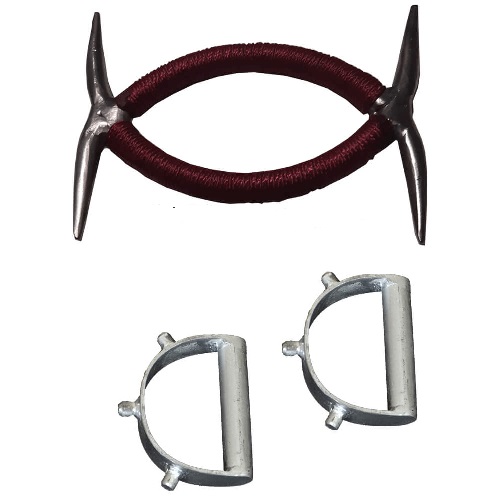Tekko Horse Shoe Okinawan Martial Arts Weapon
Welcome to our comprehensive guide on the Tekko, an Okinawan martial arts weapon. In this article, we will cover everything you need to know about this versatile weapon, from its history and origins to its usage and techniques. Our goal is to provide you with valuable insights that will help you understand and master this weapon.
Origins of the Tekko
The Tekko, literally translated as “iron armor,” is a weapon that originated in Okinawa, Japan. It’s essentially a weaponized version of stirrups and horseshoes. This distinctive weapon falls under the category of “fist-load weapons.” The main purpose of such a weapon is to increase the mass of the hand, thereby boosting the force the user can deliver, thanks to the direct correlation between the momentum of the fist and its mass. Some fist-load weapons, including the Tekko, may also serve a protective function, similar to the guard on a sword, shielding the structure of the user’s hand.
A variation of this weapon is known as the Tekko-Kagi, which translates to “back of the hand hooks.” This variant is distinguished by four iron nails resembling bear claws, which are attached to a metal ring. These claws, worn over the hands, can be utilized for both scraping and striking. The Tekko-Kagi is designed for offense and defense, allowing the user to slash at opponents and defend against attacks using natural hand movements. With proper technique, it can even be used to ensnare and disarm an opponent’s weapon.
When weapons were prohibited in Okinawa, the inhabitants ingeniously repurposed everyday items for self-defense, including agricultural tools. The horseshoe Tekko was created when Bushi in Okinawa began using their horses’ shoes as impromptu weapons to fend off surprise attacks. They would hold a horseshoe in their hand and punch with it, positioning it as a “U” with their hand in the center and the two ends extending outward.
Over time, a variation of the horseshoe Tekko was developed where two horseshoes were tied together, facing and overlapping each other. This design offered increased mass for the hand and a defensive guard. However, these weapons were larger, less concealable, and more challenging to master. An advanced version of the horseshoe Tekko had the two horseshoes welded together. Despite these improvements, the horseshoe Tekko gradually lost popularity as people started favoring the smaller, more easily concealed horse stirrup.
The horse stirrup version, known as Abumi, is formed from a semicircle connected at two ends by a bar. While some may consider this variant merely as a type of knuckleduster or brass knuckles, the traditional Okinawan stirrup Tekko does not have dividers to separate the fingers.
The traditional stirrup Tekko was made from lightweight metal and wood, contrasting with the heavy metals like brass used in modern knuckleduster versions. However, contemporary models exist made from various materials, including aluminum, wood, steel, iron, and even plastic.
Usage and Techniques
The Tekko is a close-range weapon that is best suited for quick and precise strikes. Its compact size and weight make it easy to carry and conceal, making it an ideal self-defense weapon. There are several techniques that can be used with the Tekko, including strikes, blocks, traps, and disarms.
One of the most popular techniques used with the Tekko is the punch. This technique involves striking the opponent’s body with the plate while holding the handle firmly. The punch can be used to target various parts of the body, such as the face, neck, chest, and ribs.
Another common technique used with the Tekko is the block. This technique involves using the plate to deflect the opponent’s attack, while simultaneously counter-attacking with a strike. The block can be used to defend against various attacks, such as punches, kicks, and weapon strikes.
The Tekko can also be used for trapping the opponent’s weapon. This technique involves catching the opponent’s weapon between the plate and the handle, and then disarming them by pulling the weapon away.
Training with the Tekko
Training with the Tekko requires discipline, focus, and patience. It is important to learn the proper techniques and practice them regularly in order to master this weapon. One of the best ways to train with the Tekko is to work with a qualified instructor who can provide you with personalized guidance and feedback.
When training with the Tekko, it is important to start with the basic techniques and gradually progress to more advanced techniques. It is also important to practice your footwork, timing, and distance control in order to effectively use this weapon in real-world situations.
Tekko Construction
The traditional stirrup, the predecessor of the modern Tekko, was crafted by craftsmen from metal. It was typically made from a flat bar bent into a horseshoe shape and secured with a bolt to form a “D” shape. When used as a weapon, combatants often modified this design by embedding additional bolts into the horseshoe shape to inflict more damage.
Different styles of Tekko feature sharp ends and three spikes representing the position of the knuckles, while the stirrup version of the Tekko is currently the most popular among martial arts practitioners.
Tekko vs Brass Knuckles
Some practitioners compare Tekko to brass knuckles, but unlike brass knuckles, which have finger dividers, stirrup Tekko do not.
Some Kobudo practitioners argue that brass knuckles evolved from the Tekko as the similarity between the appearance to Tekko can sometimes cause confusion.
Stirrup Vs Horseshoe Tekko
Another point of contention is the desire of some Kobudo practitioners to bring back the horseshoe Tekko. While some schools favor the stirrup version, those advocating for the horseshoe Tekko are more interested in preserving the original Okinawan cultural art forms. They argue that the horseshoe Tekko’s design aligns more closely with the functions outlined in the traditional Kata for the weapon.
Proponents of the horseshoe version suggest that it allows for new and interesting applications not possible with the stirrup version.
In terms of form and function, the horseshoe Tekko resembles specialized knives such as the “double knife,” “moon knife,” or “duck knife“.
Horseshoe Tekko emphasizes blocking and capturing incoming weapon attacks, as well as stabbing an opponent or hooking vital points.
Final Thoughts
In conclusion, the Tekko is a powerful and versatile weapon that has a rich history and culture in Okinawan martial arts. Whether you are a beginner or an advanced practitioner, mastering the Tekko requires dedication, practice, and patience. By following the techniques and training methods outlined in this article, you can become a skilled Tekko practitioner
Eager to Know More?
We hope you found this article valuable. If you’re keen to discover more about traditional martial arts weaponry, please feel free to check out the articles indicated below.
Next Martial Arts Weapons article: Kubotan Martial Arts Self Defence Weapon
Previous Martial Arts Weapons article: How to Use the Bo & Eku (Kobudo Long Weapons)
Take a glance at this well-rounded article that curates an extensive selection of Martial Arts Weapons right here at Dojo Directory.


